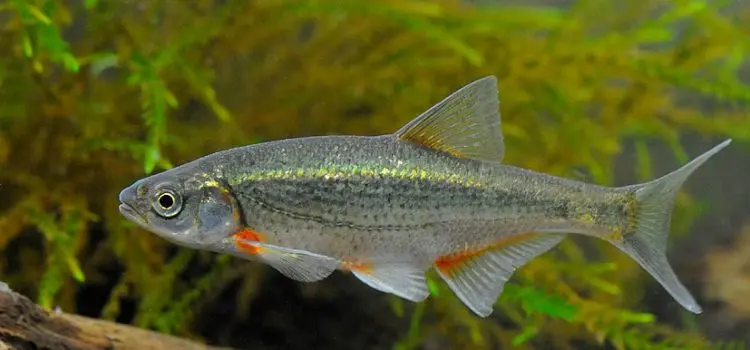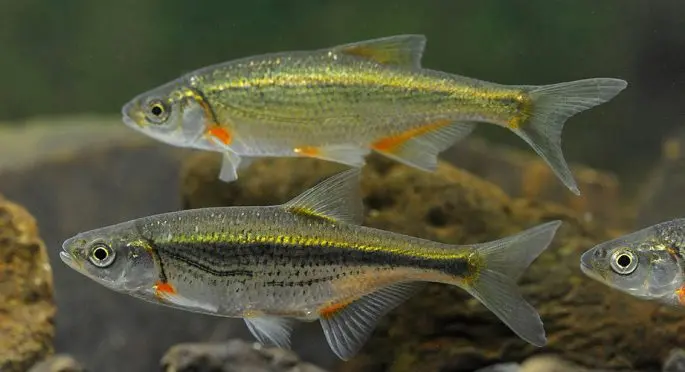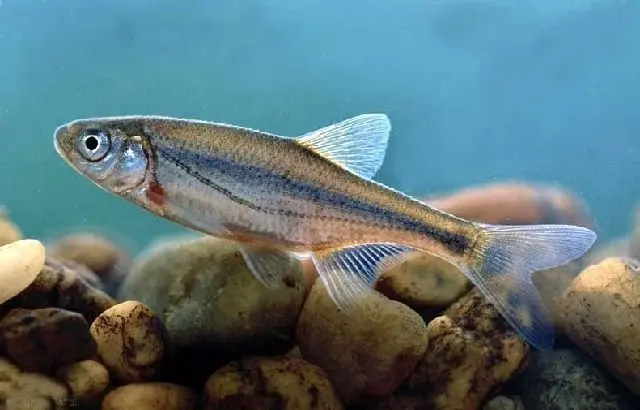
This is a small fish, which belongs to the family of carp fish species. It is often confused with bleak, since the bleak is the same size as the bleak, but if you carefully examine it, you can find dark stripes on the sides along the body on both sides.
The black stripe of this fish begins its beginning near the eyes. If you look closely, the strip is formed from small spots of a compressed shape. Closer to the tail, this band becomes barely noticeable. In addition, dark spots can be seen above the lateral line. Here they are chaotic.
If you compare a quick-wit with a bleak, then it is wider in height and more humpbacked. The head of the Bystrianka is somewhat thicker, and the lower jaw does not protrude forward in relation to the upper jaw. The dorsal fin is usually shifted closer to the head, and the number of pharyngeal teeth is somewhat less.
This is a small fish that does not grow longer than 10 centimeters. At the same time, it has an attractive appearance. The back of the bystrianka is distinguished by a greenish-brown tint.

The stripe, which is located on both sides of the body of the fish, creates a sharp contrast, with a silvery-white tint, in which the belly is painted. The dorsal and caudal fins are grey-green in color. The lower fins are grey, with yellow at the base.
Before the start of spawning, the bystrianka acquires a more contrasting appearance. The stripe located on the sides acquires a more saturated color, with a purple or blue tint. At the very base, the fins turn orange or pure red.
Spawning spawns in late May – early June, like most fish species. During this period, it cannot be confused with other types of fish.
Habitat of Bystrianka

Until now, there is no exact data on in which regions of the world the Bystrianka lives. As far as we know, she was met in France, Germany, Belgium and England, including in the southern and western waters of our state. She was not met in Finland in the northern regions of Russia. It is also known that it is widespread in Ukraine and Poland. It was not found in the reservoirs of St. Petersburg, but it was caught near Moscow, although occasionally. Most recently, it was discovered in the tributary of the Kama – the Shemsha River. Quite often, a quickie is confused with bleak, since they have an external resemblance, and they lead almost the same lifestyle.
Bystryanka chooses sections of reservoirs with fast currents and clean water, which is why it got its name. in this regard, unlike bleak, it cannot be found in reservoirs with stagnant water or in reservoirs with a slow current. It prefers to be in the upper layers of the water, like bleak, where it moves quickly and reacts to everything that falls into the water. In terms of movement speed, it is much faster than bleak.
In the process of spawning, the Bystrianka lays eggs in places where there is a strong current and the presence of stones, to which it glues its eggs. At one time, it can lay a large amount of small caviar. Sometimes the weight of caviar reaches the mass of the fish itself.
Division into types

There is a separate species of bystrianka – mountain bystrianka, which lives in the mountain rivers of the Caucasus, the Turkestan Territory and the Crimean Peninsula. It differs in a wider body, in relation to the usual quickie. In addition, she has a more rounded dorsal fin, and the fin, which is closer to the anus, has fewer rays. The mountain quickie is also distinguished by the fact that there are more dark spots on its body. It is believed that the common bystrianka originated from the mountain bystrianka. Despite this, if we compare the number of pharyngeal teeth and the shape of the body, then the bystrianka is something intermediate between bleak, silver bream and bream.
Commercial value

Bystryanka is not of any interest for its catch on an industrial scale and is considered a weedy fish. Therefore, it is caught exclusively for scientific purposes. Of course, she, like bleak, often gets on the hook of anglers, especially on a regular float fishing rod. But for anglers, it is also not interesting, except in cases where it is necessary to use it as a live bait to catch predatory fish.
Piekielnica (Alburnoides bipunctatus). Riffle minnow, spirlin, bleak









